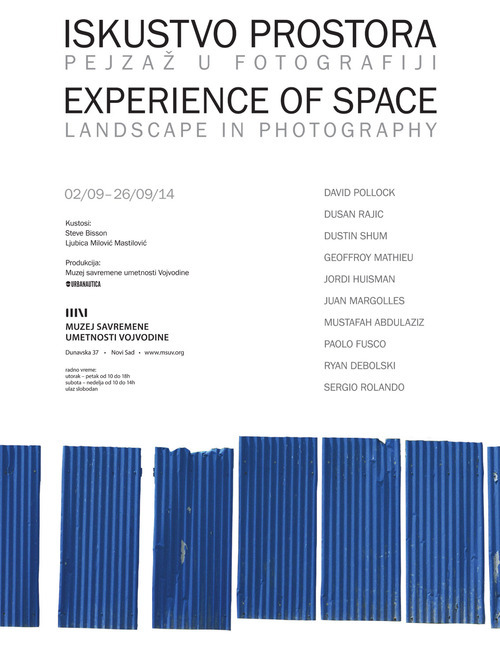
In 2013 Steve Bisson and Urbanautica were invited by the Museum of Contemporary Art of Vojvodina in Serbia to curate a new edition of 'Naturae' with curator Ljubica Milović Mastilović.
Ljubica Milović Mastilović writes about the project: «It is possible that the way in which an exhibition of photographs represents architectural research is not obvious. The link becomes clearer once it is indicated that the central issue that is being investigated here, and consequently the central issue of architecture as a profession today, is the following: what is space in the modern world?
How can the cultural legitimacy and relevance of architecture be determined? Should it be tied to the visual, physical reality of the built environment, to the social (and even economic) effects of the accumulation of values, or to the creation of “persuasive narratives”? As Ole Bouman pointed out, the question is not a new one; it is a universal, timeless dilemma in architecture.
I believe that the comprehension of space for most of our contemporaries coincides with the images and the experiences of space as it is represented in psycho-geographic investigations of the situationists. The world we live in is “subjectivized” to the highest degree: the objective reality is, in fact, a kaleidoscopic representation consisting of millions, billions of personal worlds, which are represented in images (rather than concepts) and uploaded to servers; the Internet has, with the use of optic media, become a space for generating the collective experience of life – the experience of space. The world is not what we see, but the experience of the seen conditioned by our upbringing, our experience, and our emotions.
What is the job of an architect in this context of the interpretation of space? Once we surpass the obvious necessity of “putting a roof over one’s head”, what remains is the job of creating additional non-material content and value. Space is not determined unambiguously. Optic space and virtual platforms are as relevant as the physical environment is. Architects should explore the means and the rules of creation within optic space, as they do with physical space. The space of a photograph, the space of a film, landscapes in game engines are all legitimate architectural assignments. Finding methods and ways of recreating an authentic, life-like experience of space within the optic media is, perhaps, the new future of architecture as a profession.
The exhibition “Experience of space – LANDSCAPE” is conceived as one of the possible prisms for the representation of the personal experience of space, the personal landscape in photography. A careful selection of photographic projects (Steve Bisson), completed by the essays of Natalia Reznik and Garry Green, should clearly highlight the plurality of perceiving a landscape and the multiple understanding of means through which experiences are documented and transferred; the cycle in which the interpretations of what is seen follow each other and overlap, until a person’s actual everyday world becomes an image: the accumulation of meanings which represents a specific cultural capital.
Different photographers have been invited for the exhibition: Jordi Huisman (The Netherlands), Dustin Shum (Hong Kong), Geoffroy Mathieu (France), David Pollock (Canada), Paolo Fusco (Italy), Dušan Rajić (Serbia), Juan Margolles (Argentina), Mustafah Abdulaziz (United States), Ryan Debolski (United States), Sérgio Rolando (Portugal).
The book also includes text by:
Steve Bisson (read here)
Gary Green (read here)
Natalya Reznik (read here)








…
THE PHOTOGRAPHERS
Mustafah Abdulaziz
b. 1986
United States
Water
«Water is photographic typology of a natural resource in crisis. Structured into chapters, this project reflects on our relationship with water, how we use and misuse it, to ultimately understand our place within one of the greatest challenges of our time. It is an on-going project, spanning water issues from 32 countries, created with grants from the Pulitzer Center on Crisis Reporting and commissions from the United Nations and WaterAid. The final collection of images, selected from photo essays on each water issue, will then be displayed in a touring exhibition in 2018 in order to educate and bring awareness to water as a critically global and interconnected topic.»

© Installation view. Image by Mustafah Abdulaziz
Mustafah Abdulaziz’s website here
…
Ryan Debolski
b. 1982
USA
Unfinished City
«The recent economic collapse in Dubai left an unfinished city stuck in the desert. Development in many areas slowed down considerably or even stopped completely, awaiting the funds necessary to complete projects. Buildings remained empty without any occupants in the city core. Prebuilt neighborhoods devoid of residents resembled ghost towns. Outlying areas already master planned appeared like mirages in the distance. The surrounding stagnation clashed with the expectations of the past and the realizations of the future. This photographic series documents this transitional period in a city without boundaries.»
read more here
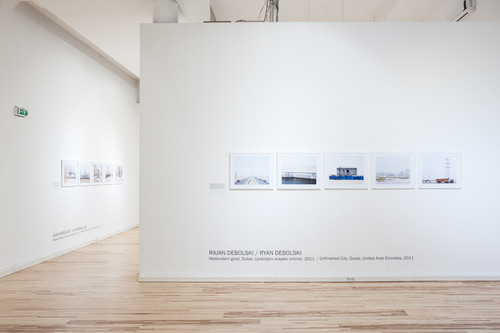
© Installation view. Image by Ryan Debolski
…
Paolo Fusco
b. 1980
Italy
Fiori 24h
«Hardly anything is open 24h in Rome: a few bars, a few stores, self service gas stations and flower kiosks, a lot of flower kiosks. You can find them everywhere in the city and they never close. They never close, and they stay open 365 days (and nights) a year. Their presence has always fascinated me, they seem like sentinels in the quiet roman night, small lighthouses populated by half-asleep immigrant workers. An hint of mystery sorrounds them, but it’s probably just a business model which takes advantage of the immigrant workers’ need to have a place to spend the night.»
read more here
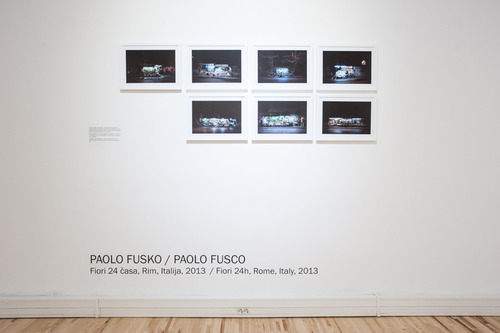
© Installation view. Image by Paolo Fusco
…
Jordi Huisman
b. 1982
The Netherlands
Close but not really and Outline
«Almere Poort is the newest part of the fastest growing city of The Netherlands, Almere. The on-going documentary ‘Close, but not really’ shows the development of the area from early 2008. It’s an investigation on how people use new residential area’s while those are not completed yet.
In the 1950’s and 60’s an area that is now known as the province of Flevoland was reclaimed from the IJsselmeer. A large dyke surrounds this polder, which lies fives meters below water level. The dyke forms an elevated outline, protecting the land from flooding. The series ‘Outline’ portrays Flevoland and its essential outline. It shows how life, infrastructure and nature got implemented after this part of the former Zuiderzee was reclaimed and land was created.»
read more here

© Installation view. Image by Jordi Huisman
…
Juan Margolles
b. 1975
Argentina
Inhabit Fedora
«Only man inhabits. A space is inhabited by individuals who leave consciously or unconsciously marks of life that represent and distinguish them. These footprints also enable us to recognize ourselves within our surrounding.
“Inhabit Fedora” reflects on this concept and analyzes residential and recreational spaces which have been designed exclusively under a principle of functionality and where evidence of the reality, questions the social function of the city in the individual and collective development of the citizens.»
read more here

© Installation view. Image by Juan Margolles
…
Geoffroy Mathieu
b. 1972
France
Marseille, Wild City
«The city is thought to be a world in itself, something which, in a sense, places us humans “outside” the world. We assume that there is an urban stage in human development, that the city dweller is a human being torn from the natural condition – and free at long last. That ties in with the common sentiment that, in the city, one is not in nature. Baptiste Lanaspeze.»
read more here

© Installation view. Image by Geoffroy Mathieu
…
David Pollock
b. 1952
Canada
Enclosure
During 2011 and 2012, I made photographs in a community garden which consists of about 140 plots in Victoria, Canada. Each plot reveals an intimate and idiosyncratic interaction between a human and the natural world.
These plots together form a larger garden, a representation of paradise, enclosed and separated from the wilderness. Hortus conclusus, literally meaning enclosed garden, is a recurrent theme in Medieval and Renaissance art and is an expression of our desire for shelter within cultivated nature and protection from the cycles of birth and death. The photographs replace a scenic description of nature with one that incorporates human activity in the process of growth and decay.
read more here
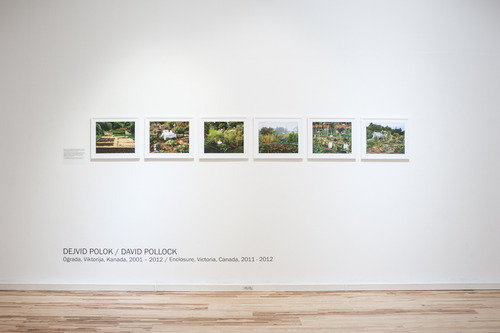
© Installation view. Image by David Pollock
…
Dušan Rajić
b. 1983
Serbia
Exile Esthetics
A series of photographs documents people without their real home, a way of their lives and their settlements. Nomads of the 21st century, driven from their homes or looking for better, are forced to make temporary shelters. Whether they are an illegal asylum seekers from East wanted to flee to the rich West or Roma from Kosovo and southern Serbia, which survive in the city, their way of life is amazingly similar. Forced to make contact with their surroundings because of mere survival at the same time must be alert to the law, police and racist violence.
read more here
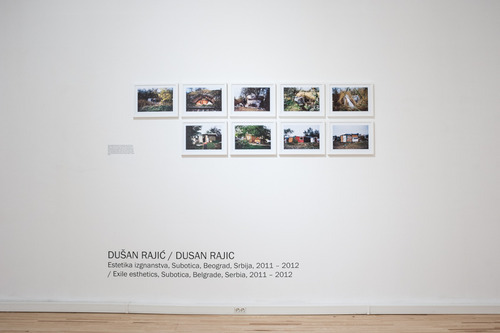
© Installation view. Image by Dušan Rajić
…
Sergio Rolando
b. 1978
Portugal
Manifold Landscape
The Douro Valley landscape is quite consensual. It is said to be unique, spectacular and sublime. It is considered a World Heritage Site. Its consumption is a continuous and insatiable desire. The omnipresence of its own image accents the illusion of conquering and belonging, showing how invasive and permanent the image of a place can be. We propose a two-fold portrayal of the figurative interpretation of Douro by the locals. Images that portray a reality removed from reflexion, which both enhance its exhaustive experience and the permanent commercialization of the region.
read more here

© Installation view. Image by Sergio Rolando
…
Dustin Shum
b. 1971
Hong Kong
«’Blocks’ is a documentary series about Hong Kong’s public housing estates. The kindergarden styled color palette of these housing fail to hide the realities public housing tenants are living in: low income, unemployment, disability, family problems, new immigrants, a society of an aging population, etc. The appearance and what is inside is simply a glaring contrast.Through these “portraits” of face-lifted old buildings, shops and restaurants folded due to sky-high rent of “Link REIT” (a real estate investment trust), the surreal as well as gloomy atmosphere of these estates that nearly half of the Hong Kong population regarded as “home” is shown.»
read more here
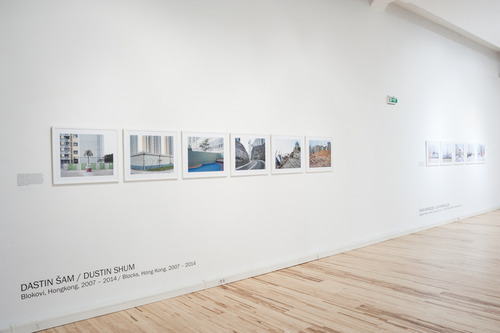
© Installation view. Image by Dustin Shum
share this page